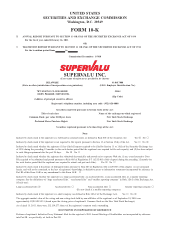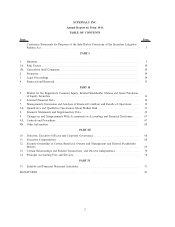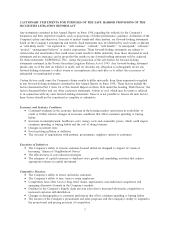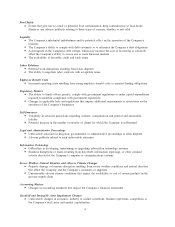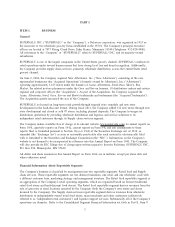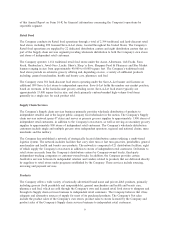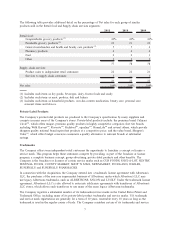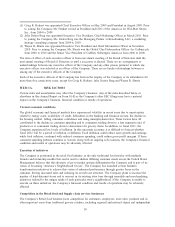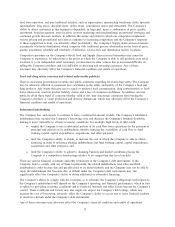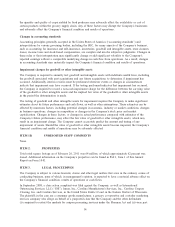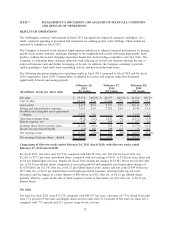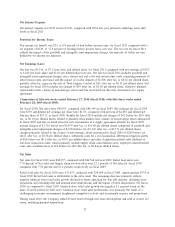Albertsons 2011 Annual Report Download - page 15
Download and view the complete annual report
Please find page 15 of the 2011 Albertsons annual report below. You can navigate through the pages in the report by either clicking on the pages listed below, or by using the keyword search tool below to find specific information within the annual report.food store operators, and non-traditional retailers, such as supercenters, membership warehouse clubs, specialty
supermarkets, drug stores, discount stores, dollar stores, convenience stores and restaurants. The Company’s
ability to attract customers in this business is dependent, in large part, upon a combination of price, quality,
assortment, brand recognition, store location, in-store marketing and merchandising, promotional strategies and
continued growth into new markets. In addition, the nature and extent to which our competitors implement
various pricing and promotional activities in response to increasing competition and the Company’s response
to these competitive actions, can adversely affect profitability. The Company’s Supply chain services business
is primarily wholesale distribution, which competes with traditional grocery wholesalers on the basis of price,
quality, assortment, schedule and reliability of deliveries, service fees and distribution facility locations.
Competitive pressures on the Company’s Retail food and Supply chain services businesses may cause the
Company to experience: (i) reductions in the prices at which the Company is able to sell products at its retail
locations or to its independent retail customers, (ii) decreases in sales volume due to increased difficulty in
selling the Company’s products and (iii) difficulty in attracting and retaining customers. Any of these
outcomes may adversely affect the Company’s financial condition and results of operations.
Food and drug safety concerns and related unfavorable publicity
There is increasing governmental scrutiny and public awareness regarding food and drug safety. The Company
may be adversely affected if consumers lose confidence in the safety and quality of the Company’s food and
drug products. Any events that give rise to actual or potential food contamination, drug contamination or food-
borne illness may result in product liability claims and a loss of consumer confidence. In addition, adverse
publicity about these types of concerns whether valid or not, may discourage consumers from buying the
Company’s products or cause production and delivery disruptions, which may adversely affect the Company’s
financial condition and results of operations.
Substantial indebtedness
The Company has, and expects to continue to have, a substantial amount of debt. The Company’s substantial
indebtedness may increase the Company’s borrowing costs and decrease the Company’s business flexibility,
making it more vulnerable to adverse economic conditions. For example, high levels of debt could:
䡲require the Company to use a substantial portion of its cash flow from operations for the payment of
principal and interest on its indebtedness, thereby reducing the availability of cash flow to fund
working capital, capital expenditures, acquisitions, and other purposes;
䡲limit the Company’s ability to obtain, or increase the cost at which the Company is able to obtain
financing in order to refinance existing indebtedness and fund working capital, capital expenditures,
acquisitions and other purposes; and
䡲limit the Company’s ability to adjust to changing business and market conditions placing the
Company at a competitive disadvantage relative to its competitors that have less debt.
There are various financial covenants and other restrictions in the Company’s debt instruments. If the
Company fails to comply with any of these requirements, the related indebtedness (and other unrelated
indebtedness) could become due and payable prior to its stated maturity and the Company may not be able to
repay the indebtedness that becomes due. A default under the Company’s debt instruments may also
significantly affect the Company’s ability to obtain additional or alternative financing.
The Company’s ability to comply with the covenants or to refinance the Company’s obligations with respect to
the Company’s indebtedness will depend on the Company’s operating and financial performance, which in turn
is subject to prevailing economic conditions and to financial, business and other factors beyond the Company’s
control. These conditions and factors may also negatively impact the Company’s debt ratings, which may
increase the cost of borrowing, adversely affect the Company’s ability to access one or more financial markets
or result in a default under the Company’s debt instruments.
Any of these outcomes may adversely affect the Company’s financial condition and results of operations.
11


